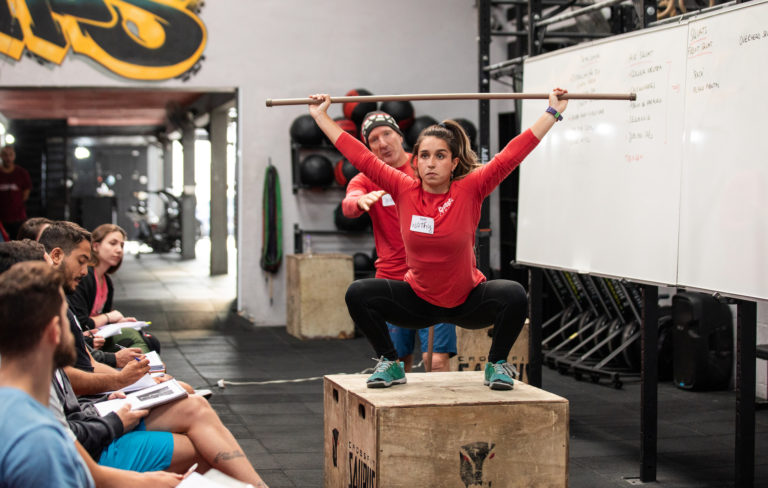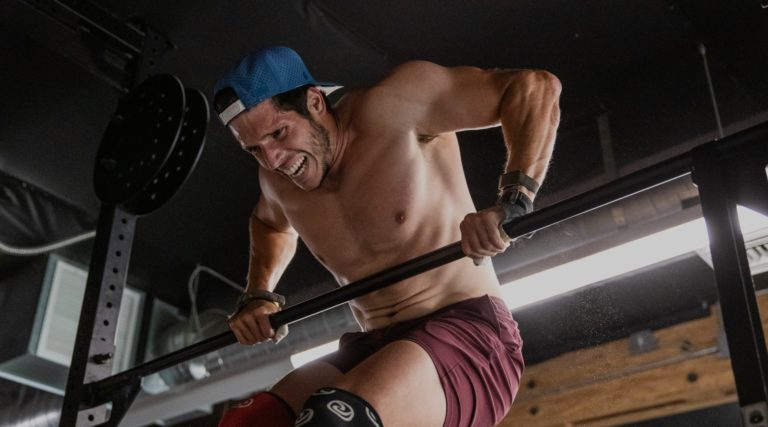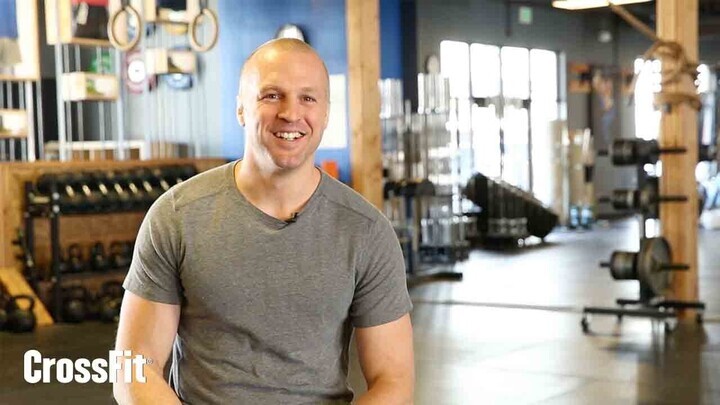Question: What’s the difference between CrossFit and HIIT?
As you read the article below, consider whether this would be a good resource for your new clients and affiliate members. If so, feel free to include it in your newsletter or onboarding material and credit “The Professional Coach.”
I recently instructed a clinic for employees of new CrossFit Games partner PBFit. Most participants had limited CrossFit exposure and were learning about the methodology for the first time. During the first lecture, someone asked, “What differentiates a CrossFit class from a typical High-Intensity Interval Training (HIIT) class?”
While not all HIIT classes are the same, and some attempt to replicate aspects of CrossFit, several clear and specific distinctions can help you answer this question the next time you’re asked.
Planned Variance
A critical component of CrossFit is constant, thoughtful variation that avoids fixed routines. This variance isn’t random but programmed to improve work capacity across broad time and modal domains. A CrossFit program consistently and thoughtfully varies loads, reps/distances, duration, movements, and workout formats. Through a week, athletes will likely experience max loads, very light loads, high-skill and low-skill gymnastics movements, running, and long- and short-duration workouts, with endless combinations to broaden experiences.
Most HIIT programs lack variance in times, loads, reps, and formats. Many daily workouts involve five to 10-minute warm-ups and cool-downs, with circuits that last 30-40 minutes as athletes move light or no load and incorporate low-skill, low-power movements. Programs that deviate from this model usually establish fixed, segmented routines (e.g., three resistance days + three cardio days weekly), which leads to stagnation and limited adaptation.
High-Skill and Functional Movements
 CrossFit utilizes compound, multi-joint movements with high-power potential. Even fundamental movements like full-range air squats and deadlifts are often absent from traditional HIIT classes, replaced by low-power isolation exercises like glute bridges and lying leg abductions. The functional movements in CrossFit involve using a full range of motion to develop targeted musculature while providing neuroendocrine benefits and improved coordination. Many people see near-immediate results in strength, endurance, coordination, and body composition just by performing these movements, even at low intensity.
CrossFit utilizes compound, multi-joint movements with high-power potential. Even fundamental movements like full-range air squats and deadlifts are often absent from traditional HIIT classes, replaced by low-power isolation exercises like glute bridges and lying leg abductions. The functional movements in CrossFit involve using a full range of motion to develop targeted musculature while providing neuroendocrine benefits and improved coordination. Many people see near-immediate results in strength, endurance, coordination, and body composition just by performing these movements, even at low intensity.
CrossFit also incorporates high-skill elements like snatches, overhead squats, handstand holds, and muscle-ups.
While many HIIT programs avoid these complex movements, practicing them builds unparalleled fitness levels.
Neuroplasticity
CrossFit isn’t just a physical workout — it’s a mental challenge that sharpens your brain as much as it strengthens your body. Every new movement, complex skill, or unexpected workout variation forces the brain to adapt, creating new neural connections in a process known as neuroplasticity. Just as muscles grow stronger with repeated effort, the brain becomes sharper and more resilient with each skill that’s mastered.
Additionally, CrossFit enhances coordination, balance, agility, and accuracy. Combining weightlifting, gymnastics, and high-intensity conditioning demands far more neurological engagement than a typical HIIT class, reinforcing both physical and cognitive performance.
Strength Development: CrossFit Goes Heavy
CrossFit unapologetically emphasizes true strength training, which many HIIT programs lack. Heavy barbell lifts, striving to improve numbers when lifts are repeated, and strategically programmed strength training sessions are key components of CrossFit programming. Athletes frequently lift near-maximal loads; these heavy sessions (80%+ 1-rep max and low-rep sets) develop intermuscular coordination and train the body to recruit as much muscle as possible to create force in a very short timeframe. This strength focus not only improves workout performance but also enhances longevity, injury prevention, and overall resilience.
HIIT programs often avoid heavy lifting, relying almost exclusively on lightweight dumbbells, bodyweight movements, or resistance bands. While these methods can develop muscular endurance, they fail to build absolute strength and power. CrossFit’s inclusion of Olympic lifts, squats, presses, and deadlifts ensures strength is developed across multiple domains — for aesthetics and real-world application.
 Intensity: Power, Not Just Fatigue
Intensity: Power, Not Just Fatigue
Counterintuitively, most HIIT sessions don’t actually drive true intensity — don’t confuse sweating and endurance training with optimal intensity. CrossFit conditioning workouts typically last under 15 minutes, allowing athletes to exert truly intense effort, whereas longer durations inherently reduce intensity. Additionally, using large-muscle, high-power movements directly correlates with intensity, which we define as power. True intensity is crucial because it’s a key driver of the results you want to garner from a fitness program.
Task-Priority Workouts
CrossFit conditioning features two main categories: task priority (complete fixed work, the score is completion time) and time priority (fixed time, the score is work completed). Most HIIT programs use only controlled time variables (e.g., 3 x 15-minute circuits), likely to simplify group management or because task-priority workouts are more challenging to implement and scale. Though seemingly minor, task-priority workouts drive higher intensity levels and remain crucial in effective conditioning programming.
Measurable, Observable, and Repeatable
CrossFit’s definition of fitness — “work capacity across broad time and modal domains” — is an objective measurement based on data collected when recording workouts. This objectivity is remarkably unique in fitness. Our program isn’t judged by appearance or opinion but by performance markers: decreased completion times, increased loads, and new skills acquired. When these broad performance markers improve, traditional health markers follow. We encourage athletes to track workouts and strategically program benchmarks to assess development accurately.
Most HIIT programs do not systematically track data or incorporate repeatable benchmark workouts that measure fitness progression.
Nutrition: The Foundation of CrossFit’s Fitness Pyramid
 CrossFit’s nutrition approach starkly contrasts with typical fitness program recommendations if they offer any at all. Nutrition forms the foundation for fitness and chronic disease prevention. Our approach — “eat meat and vegetables, nuts and seeds, some fruit, little starch, and no sugar” — simply and effectively increases protein intake while avoiding processed foods, excessive carbohydrates, and high caloric intake.
CrossFit’s nutrition approach starkly contrasts with typical fitness program recommendations if they offer any at all. Nutrition forms the foundation for fitness and chronic disease prevention. Our approach — “eat meat and vegetables, nuts and seeds, some fruit, little starch, and no sugar” — simply and effectively increases protein intake while avoiding processed foods, excessive carbohydrates, and high caloric intake.
I’m still amazed by some programs recommending up to 65% carbohydrates and as low as 10% protein. For those quantifying intake, CrossFit’s baseline recommendation of 40% carbohydrates, 30% protein, and 30% fat offers a balanced, sustainable, and effective approach that encourages higher-than-usual protein and lower-than-usual carbohydrate consumption.
Coaching: Every Workout Is Coached
CrossFit affiliate coaching far exceeds what is typically found in traditional HIIT programs. CrossFit coaches relentlessly refine mechanics, effectively instruct complex movements, build camaraderie, and manage athletes through varied workouts with effective planning and scaling. Most HIIT classes focus primarily on group management rather than mechanics and high-quality instruction — some even use TV monitors to guide workouts.
CrossFit’s blueprint of prioritizing an athlete’s mechanics before focusing on high-intensity demands the coach prioritize developing the athlete’s mastery of the fundamentals of teaching, seeing, and correcting movement at a level not seen elsewhere.
This article doesn’t aim to belittle traditional HIIT programs, which offer benefits, albeit limited ones. Understanding these key differentiators provides the knowledge necessary to answer questions comparing CrossFit to other training methodologies and helps you prepare for the next time you are asked, “What’s the difference between CrossFit and HIIT?”
Have a question for a coach? Submit here.
About the Author
 Eric O’Connor is a Content Developer and Seminar Staff Flowmaster for CrossFit’s Education Department and the co-creator of the former CrossFit Competitor’s Course. He has led over 400 seminars and has more than a decade of experience coaching at a CrossFit affiliate. He is a Certified CrossFit Coach (CF-L4), a former Division 1 collegiate wrestler, and a former CrossFit Games athlete.
Eric O’Connor is a Content Developer and Seminar Staff Flowmaster for CrossFit’s Education Department and the co-creator of the former CrossFit Competitor’s Course. He has led over 400 seminars and has more than a decade of experience coaching at a CrossFit affiliate. He is a Certified CrossFit Coach (CF-L4), a former Division 1 collegiate wrestler, and a former CrossFit Games athlete.
Ask a Coach: What’s the Difference Between CrossFit and HIIT?